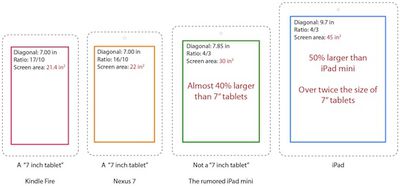With rumors of an "iPad mini" launch in the coming months ramping up, there has been much discussion about just how usable such a device would be running at the 1024x768 resolution of pre-Retina iPad models. In particular, some commenters have pointed to Steve Jobs' October 2010 discussion of the 7-inch tablets from competitors that were just then hitting the market, where he outlined Apple's belief that such tablets were too small to be useful.
While we argued as long ago as last December that scaling the iPad display down to a rumored 7.85-inch screen would still maintain usability and we provided iPad- and print- friendly examples to allow users to test for themselves, many have remain unconvinced of the benefits of a smaller iPad.
Daring Fireball's John Gruber now takes another detailed look at what an iPad mini would entail, arguing that a 7.85-inch display on an iPad mini would be a very different experience from the 7-inch screen being used by competitors such as Amazon's Kindle Fire and Google's Nexus 7.
So, how can we square the idea of Apple making an iPad Mini with Jobs’s remarks from just a year and a half ago? We could point out (again) that 7.85 inches is closer to 8 inches than 7, and that the exact size of the purported iPad Mini display offers 66 percent of the surface area of a 9.7-inch iPad, not 45 percent [as is the case with a 7-inch display]. We could point out (again) that, assuming Apple-recommended 44-point user interface tap targets on a display with 163 points per inch, it should offer tap targets of the exact same physical size as every iPhone made to date, thus avoiding the need for Apple to include sandpaper with the device.

Comparison of "iPad mini" to 7-inch tablets and full-size iPad (Source: @trojankitten, via Daring Fireball)
Gruber goes on to note that Jobs was panning small, expensive tablets running a version of Android never intended to be used on devices larger than phones and that the tablets hitting the market today are very different products. He also points to Jobs' repeated efforts at misdirection in which he publicly spoke out against certain ideas even as Apple was pursuing them, as well as Jobs' ability to quickly and decisively change his mind at times.
Beyond the size of the iPad mini, Gruber also addresses the topic of a non-Retina display in the device, suggesting that with Apple seeking to keep pricing down the display will be one of the main ways it can achieve its desired pricing while retaining significant margins. The iPad mini would naturally gain a Retina display a year or two down the road as pricing continues to drop.
Finally, in addressing pricing on the rumored iPad mini Gruber suggests that Apple could approach the $199 pricing seen on the Kindle Fire and Nexus 7 by leveraging its massive supply chain and economies of scale to bring its own costs down to the neighborhood of $150 and still maintain profitability. But even pricing of $249 could be competitive depending on hardware features and factoring in the benefits of Apple's extensive iOS/iTunes/App Store ecosystem for customers.























